Sometimes you don’t appreciate something until its absence is a matter of life and death. Such was the case for Jennifer Purvines and donated blood.
In 2018, Purvines was diagnosed with cancer. During chemotherapy, she needed three blood transfusions. “It just helped so much,” she says at a blood drive held in a Latter-day Saint chapel in St. Louis on March 3, 2021. “I went from not being able to do things that I needed to do in my life, like take a shower or walk up the stairs, to feeling pretty normal. I probably would have had to have been hospitalized. I probably would have had to quit taking my chemotherapy treatments. [The donated blood] allowed me to keep going.”
-
- St-Louis_ARC_Blood_IMG_1236.jpg
- American-Red-Cross-Blood-Drive---St.-Louis,-Missouri
- St-Louis_ARC_Blood_IMG_1189.jpg
- St-Louis_ARC_Blood_IMG_1369.jpg
- St-Louis_ARC_Blood_IMG_1316.jpg
- ARUP_Cristy-Powell---210309_155500_Cpowell__CEP5866_Cropped.jpg
- ARUP_Cristy-Powell---210309_161125_Cpowell__CEP5927.jpg
- St-Louis_ARC_Blood_IMG_1749.jpg
- St-Louis_ARC_Blood_IMG_1268.jpg
- ARUP_Cristy-Powell---210309_152852_Cpowell__CEP5792.jpg
- St-Louis_ARC_Blood_IMG_1574.jpg
- American-Red-Cross---St.-Louis-March-2021
- ARUP_Cristy-Powell---210309_163727_Cpowell__CEP6052.jpg
- ARUP_Cristy-Powell---210309_164309_Cpowell__CEP6082.jpg
- St-Louis_ARC_Blood_IMG_1402.jpg
- ARUP_Cristy-Powell---210309_175151_Cpowell__CEP6260.jpg
- St-Louis_ARC_Blood_IMG_1321.jpg
- St-Louis_ARC_Blood_IMG_1428.jpg
- ARUP_Cristy-Powell---210309_152852_Cpowell__CEP5792.jpg
- St-Louis_ARC_Blood_IMG_1388.jpg
- St-Louis_ARC_Blood_IMG_1281
- St-Louis_ARC_Blood_IMG_1327.jpg
- St-Louis_ARC_Blood_IMG_1717.jpg
- St-Louis_ARC_Blood_IMG_1628.jpg
- St-Louis_ARC_Blood_IMG_1634.jpg
| Temple Square is always beautiful in the springtime. Gardeners work to prepare the ground for General Conference. © 2012 Intellectual Reserve, Inc. All rights reserved. | 1 / 2 |
Donate blood today at a blood drive near you: The American Red Cross | ARUP Blood Services of Utah
Some 25% of blood donations in the United States are given to cancer patients such as Purvines, says David Staszak, divisional vice president of the American Red Cross’s southwest and Rocky Mountain area. Between cancer treatments, victims of car accidents, sickle-cell patients and others, the need for volunteers at blood drives is perennial.
Purvines is now cancer-free but unable to donate blood because of chemotherapy. Yet she still finds ways to give back. She has volunteered at some 30 American Red Cross blood drives during the COVID-19 pandemic. She and other members of The Church of Jesus Christ of Latter-day Saints have participated in 2,500 American Red Cross-sponsored blood drives in the United States since January 2020. Each volunteer is a small and simple extension of a longstanding partnership between the Church and the American Red Cross that dates to the late 19th century.
Today, Staszak says, the Church is the American Red Cross’s “top organization” in terms of units of blood donated (88,500 since January 2020) and in the number of blood drives it has helped host. The Church, he says, “may be responsible for tens of thousands of lives saved” in the past year. The partnership has proven especially indispensable during the pandemic. Staszak says cancelations tripled in 2020 — at times reaching as high as 50% in some areas.
“The Church of Jesus Christ of Latter-day Saints ultimately has helped us bridge that gap so that we can continue to collect blood and help those patients in need,” he says. With the American Red Cross collecting an average of 5.5 million blood and platelet donations from 2.6 million blood and platelet donors annually, he notes that the Church’s 88,500 donations during the pandemic are “significant.”
Latter-day Saints are also the top group of volunteers for ARUP Blood Services of Utah. The ARUP laboratory is the sole blood provider for University of Utah Health, the Huntsman Cancer Hospital and Shriners Hospital for Children (both located in Salt Lake City).
Over the past decade, the Church has helped save “thousands upon thousands of lives” by hosting more than 1,500 blood drives with ARUP, says its community relations representative Jason Parr.
Like the American Red Cross, ARUP saw numerous no-shows at its blood drives toward the beginning of the pandemic. But thanks to the Church, Parr says, ARUP blood drives have continued uninterrupted.
“[The Church is] the one organization that we work with in all [of Utah] that’s been able to continue helping,” he says. “We have blood drives every week with different stakes in the Church. We are really grateful for them.”

St-Louis_ARC_Blood_IMG_1749.jpg
Colette Melby prepares to donate blood in Fenton, Missouri, March 3, 2021. 2021 by Intellectual Reserve, Inc. All rights reserved.Why Should You Give Blood?
The University of Utah Health System, which includes four hospitals and serves patients throughout the Mountain West, has an ongoing need for blood. They serve trauma, burn and cancer victims, as well as those in need of bone marrow or organ transplants.
“We really need to be ready for those things that are unexpected, like accidents, but also the ongoing needs every day,” says Kelly Cail at an ARUP-sponsored blood drive at one of the Church’s chapels on March 9, in Sandy, Utah. She is the operations director of transfusion medicine at the University of Utah Hospital
“The surgery schedules never stop, Huntsman [Cancer Hospital] never stops,” Cail says. “The need is just always there.”
The call for blood has only increased during the pandemic because many people seem to have hit the pause button on their health care, Cail says. “People are coming into the hospital almost sicker than ever. They may have delayed their surgeries, and now those operations are even more significant. And we’ve noticed an 11% increase in blood usage this past year, as well as an 8% increase in the number of patients needing blood transfusions.”
Cail says a unit of donated blood can stretch further than people think.
“When you donate whole blood, it can actually be separated out into multiple components. It can go into three different components — packed red blood cells, fresh frozen plasma or platelets. So with one donation — a few minutes of your time — you can save up to three lives.”
Cail and Staszak recognize that those who qualify to donate blood may not want to — perhaps from a fear of needles or to avoid contracting COVID-19 or some other reason. Both reassure potential donors that giving blood is not only safe — it is perhaps safer than it has ever been.
Both the American Red Cross and ARUP Blood Services of Utah follow strict guidelines to prevent the spread of disease. Donors are greeted with a temperature check and are encouraged to use hand sanitizer. Donor beds are spread out as a social distancing measure. And donation appointments are spread apart to avoid having too many people in the room at one time.
“We’ve learned so much during this pandemic that I think we’ll take with us forever,” Cail says. “Simple precautions like wearing masks, distancing, and hand washing. Everything is single-use. We’ve given our employees vaccinations. We test them regularly. You really couldn’t have a safer time than right now to donate.”
“People should not hesitate on giving blood,” Staszack adds. “With all the precautions that we take, they should feel safe. … The worst part of giving blood that I’m sure everybody dreads is that initial poke. But once it’s there, it’s so easy.”
In addition to the safety and health of the donor, the sheer demand of blood donations is a compelling reason to give, Staszak says. As stated earlier, a quarter of donated blood is used by cancer patients. And, according to the American Red Cross website, only 3% of age-eligible people donate blood yearly.
“My father had cancer, and I watched him during a seven-month period get blood transfusions every other week,” Staszak says. “And what was amazing during that time — in just a matter of hours, his color comes back, his energy comes back. I firsthand saw the immediate help of what just one unit of whole blood did for my father and, theoretically, it extended his life by seven months.”
Cail says several people in her family have been blessed by donated blood. Her husband, for example, needed 13 units after a traumatic accident. And a cousin went from a listless, leukemia-stricken girl to one brimming with life thanks to the gift of donated blood.

ARUP_Cristy-Powell---210309_152852_Cpowell__CEP5792.jpg
An ARUP employee helps a blood donor donate blood in Sandy, Utah, March 9, 2021. Blood drives like this are scheduled in hundreds of meetinghouses of The Church of Jesus Christ of Latter-day Saints each year.2021 by Intellectual Reserve, Inc. All rights reserved.“We’re eternally grateful for those people that donated,” Cail says. “I’ve been able to see just through my own family how important it is when those blood donors come in and give of themselves.”
These stories are reminders that, as Staszak says, blood cannot be manufactured. Donations come from people. Because recipients usually do not receive blood until they need it, “you know that when a person is transfused with blood, they are receiving immediate help,” he says. “There is not a more special gift that one person can give to another person.”
Whether you donate at a Church-sponsored event or at a donor center, Cali says, the most important thing is that you donate.
“It’s a great time for friends or family to get together and come in and give the gift of life,” she says. “I think it’s the greatest gift you’ll ever be able to give.”
Visit UtahBlood.org to find the nearest ARUP donation opportunity.
Visit RedCross.org for a blood drive close to you.
